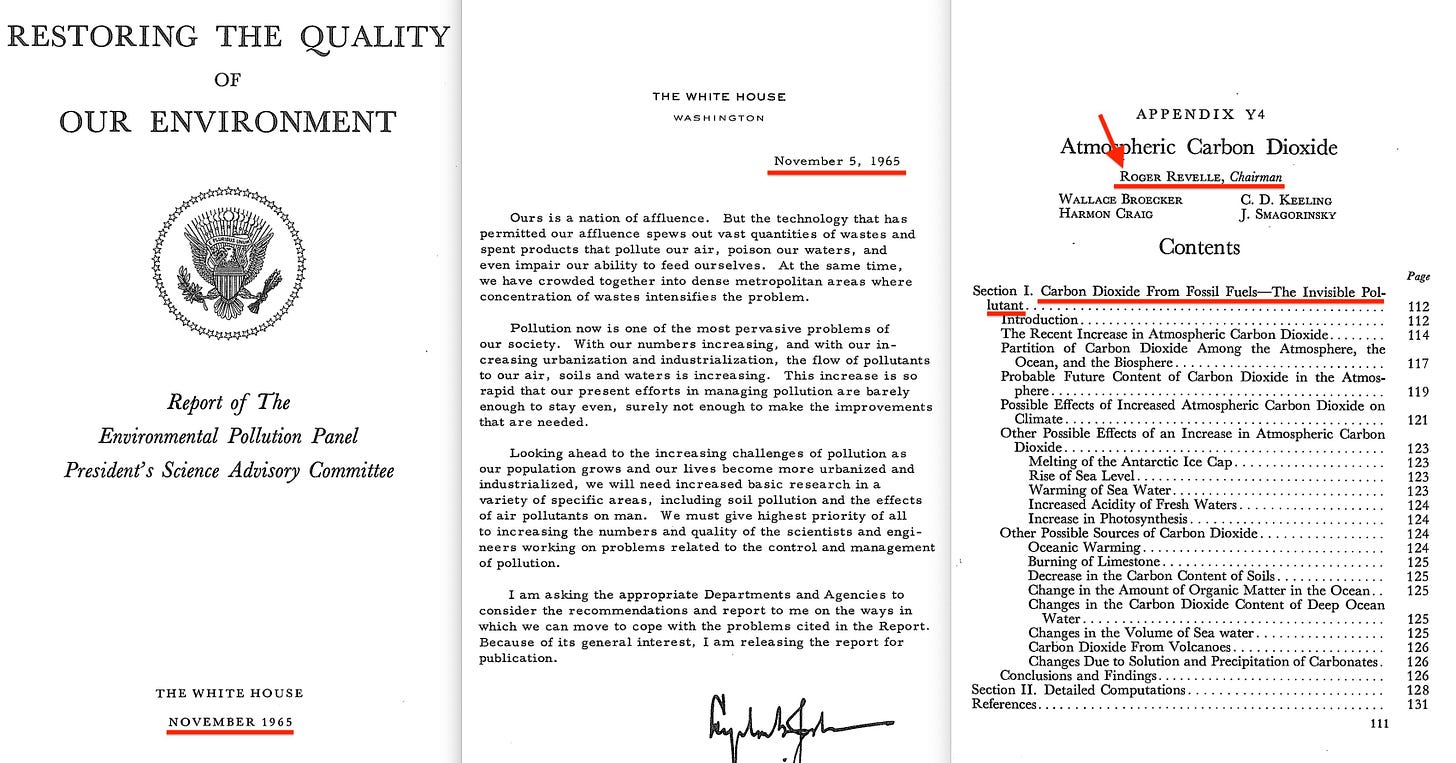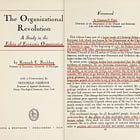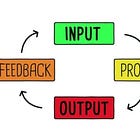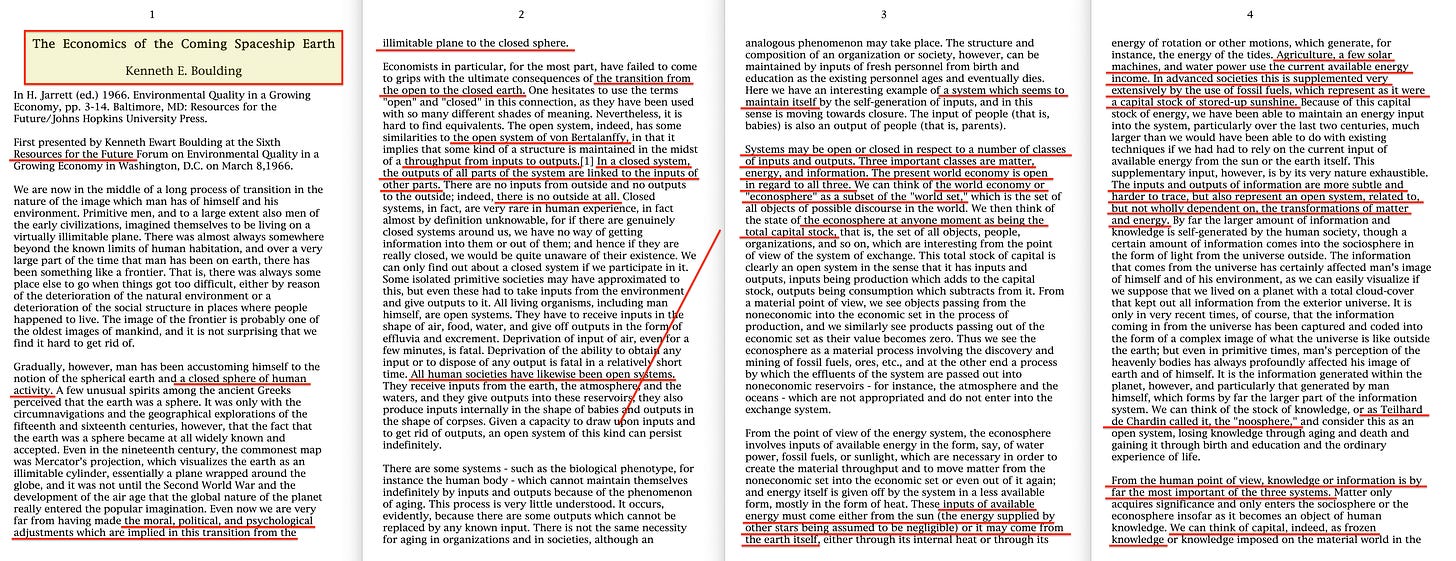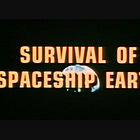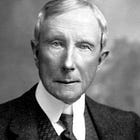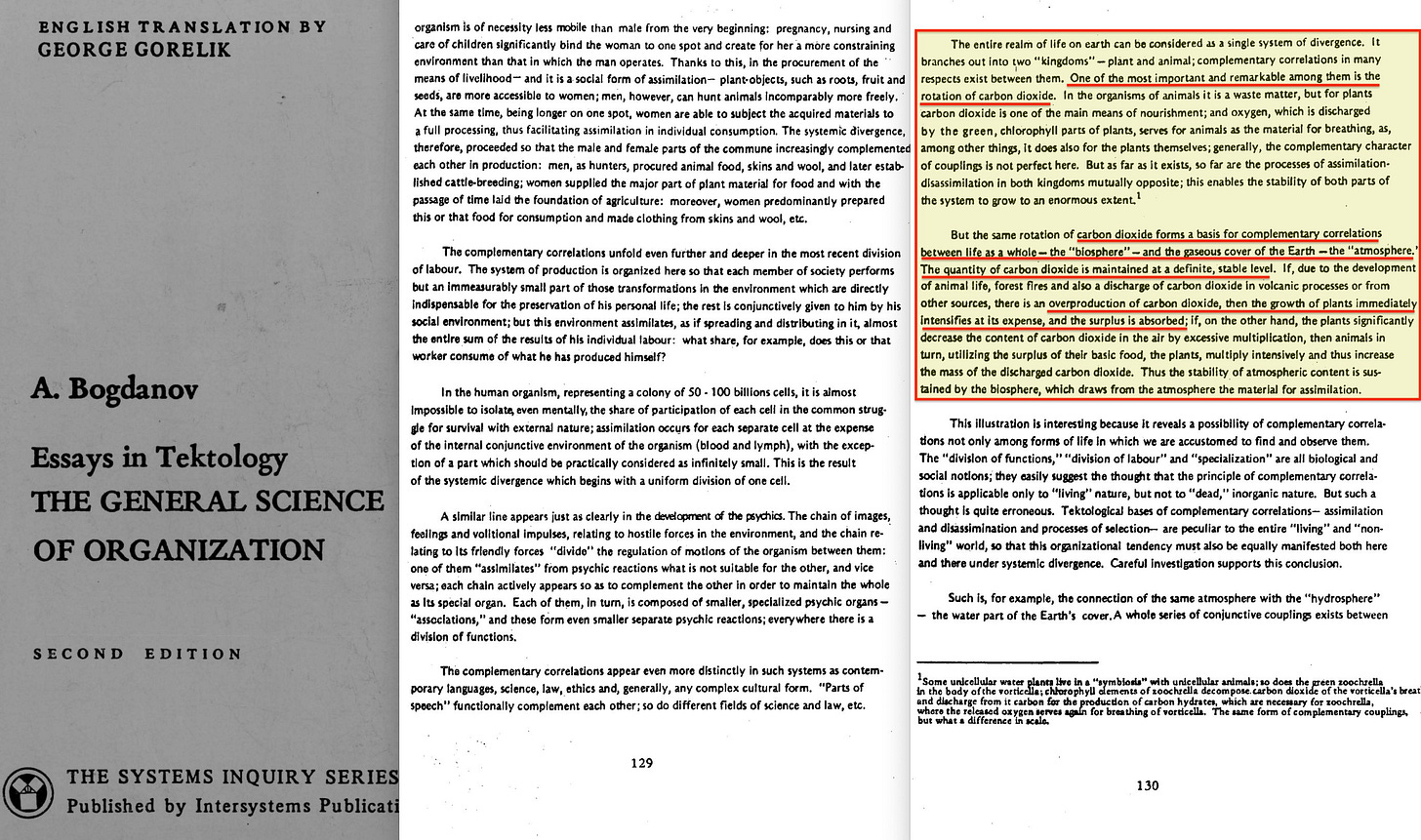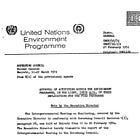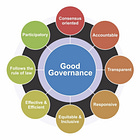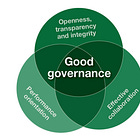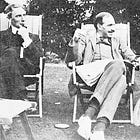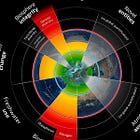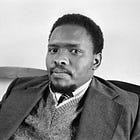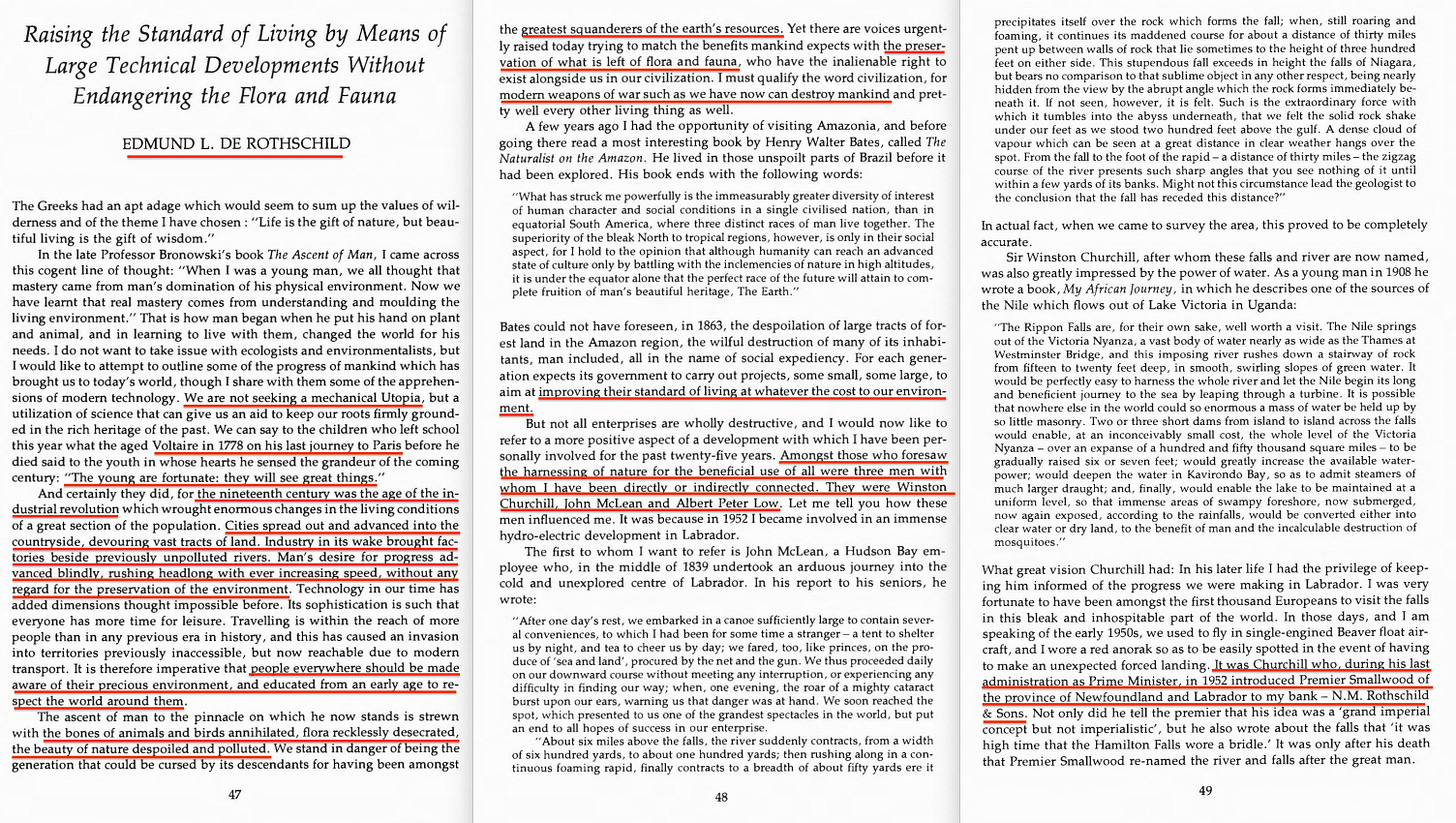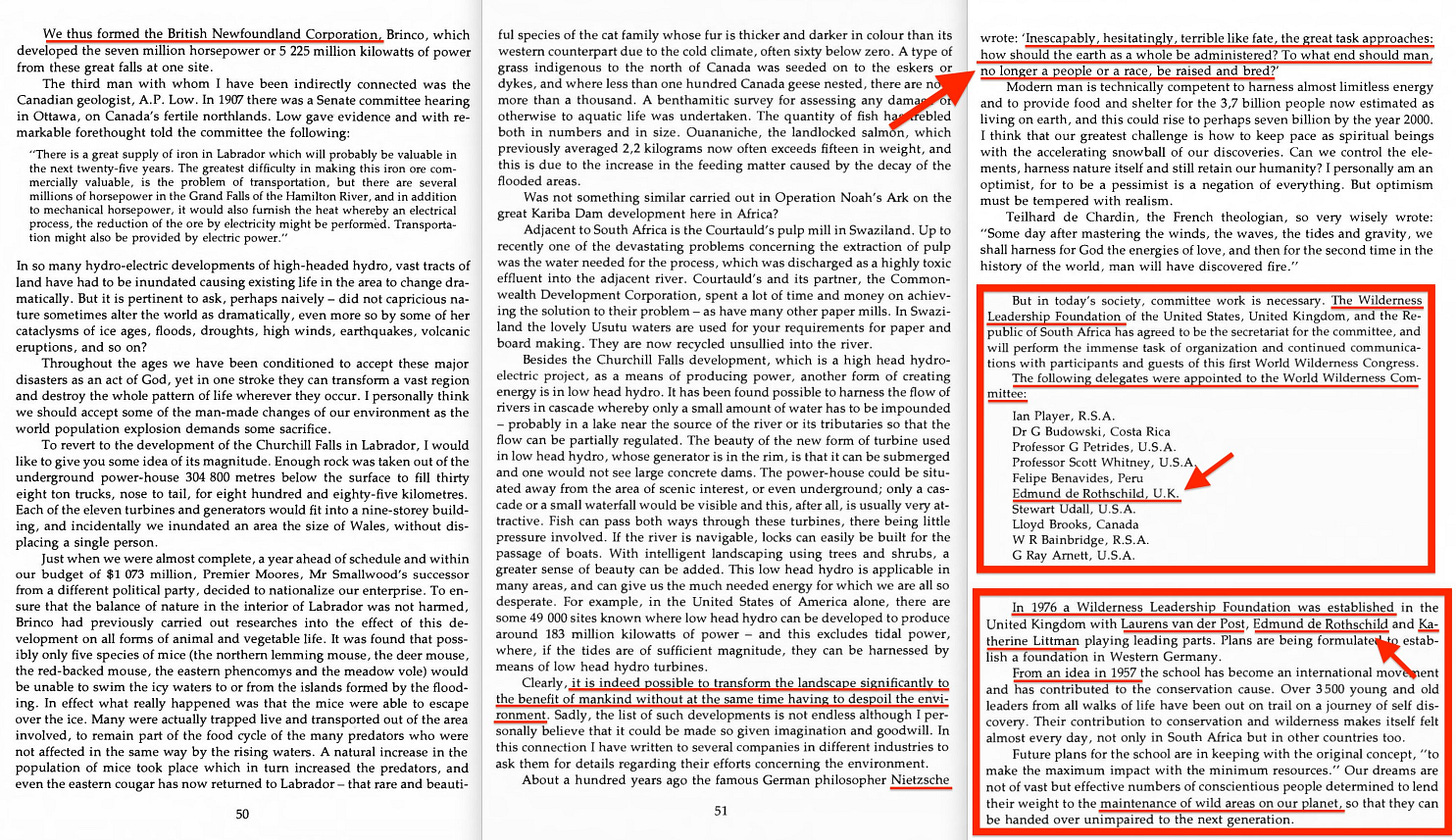Grammar of Control
He who controls the universal monetary grammar controls the universal moral grammar.
He who controls the universal moral grammar controls the universal science grammar.
The Venice Declaration
It perhaps sounds cryptic at first, but it’s actually fairly simple. And it further reveals our contemporary architecture of power — a system where those who create and allocate money ultimately determine what counts as ethical, and consequentially, what counts as scientific truth.
But to understand how — and why — we need to briefly revisit two key documents, beginning with the Venice Declaration.
What makes the 1986 Venice Declaration so special, is that it marks the first moment calling for science to subdue to ethical values. But where should those ethical values come from? Simple — modelled data predictions, such as alarmist ‘climate change’ narratives. This aspect was discussed through the 1985 document, UNESCO World Modelling1, sourced by the 1986 event, ‘Science and the boundaries of knowledge’2 which delivered said ‘Venice Declaration’. ICSU’s 1996 initiative, SCRES3, is then applied to the pipeline of scientific research, and the outcome of the science is then delivered to the public — and filtered — through UNESCO initiatives such as COMEST4 and ‘The Right of Access to Information’5 (with suitable exceptions, of course), while other ‘ethics declarations’ deals with mainstream media6, business and others, even religion. In other words:
Modelling Science…
IIASA, IPCC (founded 1988) and others predicting hyped, global disasters, doing Digital Twin simulation on the planet in order to predict future outcomes.… leads to…
Ethics…
‘Climate change’ then predicts 10 trillion deaths, and this is translated into a moral imperative. Because you don’t want people to die, right?… leads to…
Science…
Moral imperatives — ICSU’s SCRES from 1996 — then demands that science itself gets in line, affecting what is allowed researched, and for what purpose (or else lose funding).
… leads to…Information
The deliberation of science to the people is then ‘steered’ through UNESCO’s 1997 initiative, COMEST, affecting how ‘climate change’ or ‘biodiversity breakdown‘ is communicated with the people, and censored through UNESCO’s ‘The Right of Access to Information’.
In other words: the models justify the moral imperatives, the moral imperatives justify neutered science, and the neutered science filters through to managed, public information — because we quite simply cannot have anyone dare questioning ‘climate change’, or ‘pandemic potentials’ while trying to ‘save lives’, right? Leave no one behind7, and all.
This is how it functionally operates. More detail on the full pipeline can be found in the article on ‘The Death of Democracy’, because culture, arts, education and even religion are similarly affected by this top-down application of… well, call it whatever you will, but democratic deliberation it certainly isn’t.
In Tandem
But the IIASA cannot spread narratives of fear themselves lest they lose their questionable public status as ‘independent’ and ‘objective’. Ergo, they need a non-government organisational front to take the ‘best scientific consensus available’ to the governments, applying pressure for these to accept… whatever transfer of power to technocrats simply required to solve the crisis existing… only on IIASA mainframes. And these alarmist predictions further require continuous and consistent funding. Unfortunately, the democratic process tends to get in the way of that, because political parties might disagree. Hence, we need ‘expert’ rule to replace traditional, classic liberal western-style democracy.
That’s where the Fabian Society’s 2023 ‘In Tandem’ arrives on stage, suggesting the transfer of fiscal powers to the EPCC when monetary policy becomes useless as the lower bound is hit8. Never mind that it’s the central banks’ express responsibility to ensure this doesn’t happen in the first place, because central banks are pretty damn certain that central banks under no circumstances should accept responsibility for central banks poorly carrying out the operational mandate of central banks9. The central banks are beyond reproach and will not accept blame, prole.
The Fabian ‘idea’ suggests fiscal policy should be set through the EPCC during crisis ‘lower bound’ conditions. Just one problem — the crisis will be called by the Office of Budget Responsibility (OBR), or the Office for National Statistics (ONS), neither of which were ever elected, and thus cannot be held democratically accountable.
The OBR — created in 2010 specifically to constrain government fiscal freedom in the wake of the financial crisis — controls economic forecasting models that determine when the economy is ‘approaching crisis conditions’. Through selective parameters, assumptions, and choices of methodology, these models are flexible and can be used to generate forecasts showing economic deterioration that requires aggressive monetary easing — which in turn will push rates toward the lower bound. Meanwhile, the ONS — whose inflation calculation methodology such as component weights can change without public awareness — determines what constitutes economic reality. Inflation calculations, GDP measurements, employment statistics — all can be adjusted by the ONS through technical changes that make economic conditions appear better or worse than alternative measurements would otherwise suggest, a fact easily observed through their ludicrously low inflation statistics in terms of food prices10.
When OBR forecasts predict an incoming economic downturn and ONS statistics suggest deteriorating conditions, this creates pressure for Bank of England interest rate cuts. The BoE, citing these ‘independent’ assessments, lowers rates toward zero — the lower bound where monetary policy becomes ineffective. Crucially, the OBR's own forecasts help create the conditions they predict. When government policy is constrained by OBR fiscal rules and economic projections, this can actually worsen economic performance, making the forecasts self-fulfilling.
With the lower bound reached and ONS data confirming ongoing economic problems, the EPCC mechanism will automatically trigger. The BoE can now write statutory letters demanding ‘fiscal coordination’, citing the OBR/ONS data as evidence that monetary policy alone is insufficient. The beauty is that the crisis will appear statistically objective — it's allegedly not political opinion but mathematics derived from ‘official economic data’. Yet the OBR and ONS — as unelected technocratic bodies — control the methodological frameworks that generate these ‘facts’. And with the lower bound delivered, fiscal policy powers — taxation and spending — are transferred to the EPCC, which beyond the (democratically elected) UK Treasury, also counts a hand-picked non-government organisation, there to suggest for what purpose fiscal policy should be eased (increased public spending), as well as the Bank of England who will suggest how, and why it should be funded (taxes and/or quantitative easing).
NGOs involved include those working in fields like social, economic, and environmental justice, while the UK Treasury and the Bank of England are present regardless of context. The NGOs will typically push indicator-based Digital Twin predictions, perhaps even IIASA global modelling outcomes. In other words, the NGOs act as little but fronts for the modellers, and the Bank of England will thus drive tax and spend policy entirely outside democratic capacity on account of global modellers such as the IIASA or IPCC — similarly outside democratic reach.
And this is all ‘justified’ through opaque black box modeling, making insider interest appear objective, yet delivered to the government as scientific necessity.
The Fabian Society
So what we have is global modellers forward predicting… with impunity, NGOs drumming up fear… with impunity, central banks mismanaging the economy… with impunity, the ONS and OBR cooking up stats… with impunity, the mainstream media parroting insider opinion… with impunity… and Truss and Kwarteng being booted for not pre-approving their budget by the Bank of England11. Never mind UK Gilts presently trade at levels far worse then what led to the dismissal of Truss and Kwarteng. The present BoE governor, Andrew Bailey, coincidentally happens to be a fabian socialist12, along with all senior members of the present ‘Labour’ UK government — and the ‘independent’ media were progressively bought up by wealth funds and billionaires over the past decades, making their claims of ‘independent’ reporting seriously questionable.
But should we briefly examine who’s in a position of power in this relationship, it becomes quite clear what’s actually going on:
The voter (and thus the government) is progressive stripped of power as we inch towards the ‘meta-crises’.
The ONS and OBR cook up statistics, they do not actively set policy.
The NGOs are interchangeable, typically only recommending fiscal spending policy objectives on basis of forward predictions.
The Global Modellers produce said forward predictions through Digital Twin simulations of (global) surveillance ‘indicator’ data.
And the Bank of England control the monetary and the fiscal policy during the ever-predictable and eventually continuous ‘crises’ called.
In other words, the three organisations gaining in this context are the NGOs, the modelling agencies, and the Bank of England, who will claim they merely ‘recommend’. Except, of course, when government refuse these ‘letters’ and ‘recommendations’ they will be promptly ‘Truss’ed’ as a result.
Yet, the NGOs are only there to suggest moral objectives for spending, and their arguments thus lead back to the global modellers, meaning it’s ultimately between them and the Bank of England.
Black Box Modeling
Black box models serve as a crucial translation mechanism, converting insider interest into scientific authority. These systems are specifically designed to be ‘too complex for democratic oversight’ while generating outputs that consistently favor expert coordination over democratic accountability… with impunity. Because democracy allegedly cannot prevent ‘biodiversity breakdown’ predicted by opaque IIASA models.
When ONS and OBR economic models indicate that fiscal policy must be coordinated with monetary policy, when climate models suggest that carbon pricing is essential, when inequality models recommend specific redistribution mechanisms — the technical complexity makes it impossible for most people to trace… how these conclusions ultimately serve central banking interests.
The models do not — per se — suppress alternative conclusions, they rather make alternative methodologies used to reach said conclusions appear unscientific and immoral. By controlling the technical standards for legitimate analysis, authorities ensure that all credible research leads ‘in the right direction‘. The strategy here is to present a scenario where those who seek to ‘do their own research’ will adapt mechanisms and tools deliberately engineered to lead ‘in the right direction’.
The black box nature thus provides plausible deniability — people have a genuine belief in their objectivity, even when these implement systematically biased frameworks. And this works to create epistemic architecture — converting elite interests into apparently neutral scientific outputs that appear to emerge from valid technical analysis rather than predetermined institutional priorities.
But, in reality, it’s all captured through second-order manipulation.
Universal Organisational Science
Alexander Bogdanov no doubt was a brilliant man. When I initially encountered his ideas, I was somewhat amazed by what I perceived to be truly inspired thought, even struggling to comprehend the train of thought which led to his theories. And so I was when encountering the UNESCO Biosphere Conference13 and the first and third SCOPE reports, detailing the global surveillance system for Spaceshipe Earth in astonishing detail, dating back to 1968, 1971 and 1973. Of course, the Club of Rome similarly was launched in the year of the biosphere conference — and that’s somewhat of a major hint right there.
But Bogdanov himself leaves a few hints through his writings which point to the same applied perspective, naturally leading to these insights. And it’s a perspective later established firmly through Kenneth Boulding’s pivotal 1966 paper, ‘The Economics of the Coming Spaceship Earth‘, first published at the Sixth Resources for the Future Forum on Environmental Quality in a Growing Economy in March, 1966.
All terribly convenient, not just because this forum followed on from the November, 1965 report ‘Restoring the Quality of Our Environment’ which through mr $1m Rockefeller grant man, Roger Revelle, promoted alarmist predictions of atmospheric co2 concentrations using the ludicrous 1963 Conservation Foundation established ‘carbon consensus’ as its sole source. And this report came in, immediately before the December, 1965 event, ‘The White House Conference on International Cooperation‘, at which Joseph Fisher of the Ford and Rockefeller funded Resources for the Future, Russell E Train of the Rockefeller funded Conservation Foundation, and Harold Coolidge of the IUCN at this event first discussed a concept which eventually led to the UNESCO World Heritage Convention14.
However, it was similarly the Resources for the Future who in 1963 established the Contingent Valuation Model in context of recreation value — eventually developed into a mechanism to establish the value of author of ‘The Population Bomb’15, Paul Ehrlich’s concept of ‘ecosystem services’.
In other words — to briefly summarise this ludicrous chain of events:
1963: The first, absurd ‘Climate Consensus’ is established by the Rockefeller Foundation funded Conservation Foundation16.
1963: The ‘Contingent Valuation Model’ in context of estimating value of conceptual ecosystem services is established by the Ford and Rockefeller Foundation funded Resources for the Future17.
1965: ‘Restoring the Quality of Our Environment‘ is published, a report by Roger Revelle (funded by the Rockefeller Foundation), dialling the fear of atmospheric armageddon up a few notches.
1965: ‘The White House Conference on International Cooperation‘ is held, at which key people of the Resources of the Future, Conservation Foundation, and the IUCN begin the drive for the UNESCO World Heritage Convention18.
1966: Boulding’s ‘The Economics of the Coming Spaceship Earth‘ is published at a Ford and Rockefeller Foundation funded Resources for the Future Forum19.
In the event this doesn’t appear quite ludicrous enough already… just wait until you realise what’s in Boulding’s report.
See, Boulding describes Spaceship Earth as a ‘closed sphere of human activity’ which calls for ‘moral, political, and psychological adjustments‘. And this is drawn in the context of Bertalanffy’s open system (General Systems Theory), which Boulding in 1956 incidentally developed by imposing hierarchical order through his paper, ‘The Skeleton of Science’. In essence, while Bertalanffy broadly described General Systems Theory as network topology, Boulding structured General Systems Theory into what Koestler through ‘Ghost in the Machine‘ later would describe as ‘holons’20.
Spaceship Earth, in Boulding’s view, is further a closed system, meaning that no material escapes. This isn’t technically correct, of course, not just because of the sun, but also because of subatomic reactions. Yet he, in essence, suggests that we’re stuck on a spaceship, and the resources we have at our disposal are finite, and this calls for a radical change to our peercention of the spaceship itself. See, this leads the call for resource extraction and use to now focus on conservation and matters of measuring inputs and outputs, and where possible, outputs from one operation becoming inputs for the next. And this, essentially, is Wasily Leontief’s Input-Output Analysis, based on Operations Research.
Thinking of the world as a closed system through the metaphorical Spaceship Earth thus logically leads to a call for input-output analysis to be run on any critical resource. And the way you do that, is through comprehensive global surveillance of key materials. And that, in turn, leads to the Circular Economy21.
But we are only getting started, because in rapid order, Boulding identifies fossil fuels as not only exhaustible, but also identifies these as ‘pools of stored sunlight’, an ideological expression squarely in line with the vision of Technocracy, Inc.
The economy, thus, becomes a subset of the total ‘world set’, while the input-output flows through information is also considered as an open system, which directly affect transformation of matter and energy. In other words, all use of energy resources are directed by information, and this affects not only the spent energy resources, but further also material resources, possibly altering information resources in the process. And it’s at this stage that Boulding links to Teilhard’s concept of the Noosphere, which in brief represents the total, accumulated sphere of human consciousness.
The paper is really interesting, not simply because it identifies the stock of material, energy, information, and knowledge as pivotal. And these — and interactions between — can broadly be considered through energy-to-material (General Systems Theory), information-to-energy (Cybernetics), information (Information Theory), and knowledge-to-information (Resilience Theory). However, in a closed system, all production outputs should be considered as recycled inputs for production (Circular Economy), with a given example being the nitrogen cycle of the natural ecosystem — incidentally a topic of SCOPE’s 7th report22 from 1975 (oh, did I mention that both ICSU and SCOPE were funded in those days by Ford and Rockefeller?).
Nuclear energy is dismissed, as fissionable material is considered limited in supply as well. And though that is technically accurate, and no point does Boulding consider counterpoints here, that we could develop new sources, or new ways to extract energy through nuclear processes. Every aspect considered is a dead end, to Boulding. And that’s somewhat telling, because that completely dismisses any kind of future development in that regard.
Boulding then speaks of information entropy, and lands with social and cultural systems, which of course align perfectly with UNESCO’s present focus on Cultural Heritage23, before Boulding himself summarises it perfectly:
The closed earth of the future requires economic principles which are somewhat different from those of the open earth of the past. For the sake of picturesqueness, I am tempted to call the open economy the "cowboy economy," the cowboy being symbolic of the illimitable plains and also associated with reckless, exploitative, romantic, and violent behavior, which is characteristic of open societies. The closed economy of the future might similarly be called the "spaceman" economy, in which the earth has become a single spaceship, without unlimited reservoirs of anything, either for extraction or for pollution, and in which, therefore, man must find his place in a cyclical ecological system which is capable of continuous reproduction of material form even though it cannot escape having inputs of energy.
The future Spaceship Earth, thus, calls for radical new economics (the end of capitalist principles, commonly referred to by Ervin Laszlo), and that the spaceship is a closed system requiring continuous recycling (enabling the Circular Economy and a full General Systems Theory perspective of Planet Earth). And to this end:
It should be possible, however, to distinguish that part of the GNP which is derived from exhaustible and that which is derived from reproducible resources, as well as that part of consumption which represents effluvia and that which represents input into the productive system again.
Thus, we have renewable resources, and we have non-renewables. Yet, what matters is:
The essential measure of the success of the economy is not production and consumption at all, but the nature, extent, quality, and complexity of the total capital stock, including in this the state of the human bodies and minds included in the system… we are primarily concerned with is stock maintenance, and any technological change which results in the maintenance of a given total stock with a lessened throughput (that is, less production and consumption) is clearly a gain.
A global stock-take of natural resources, for the purpose of maintaining overall supplies. Next, Boulding considers human welfare in the perspective of Paul Carus’s eternal:
On this view, there is nothing desirable in consumption at all. The less consumption we can maintain a given state with, the better off we are.
Cue the ‘degrowth’ movement. And we are still not done with the document.
Because what Boulding is actually trying to say is that only when we consider the full set of information in the aspect of Carus’s eternal — and by that is meant future generations and their resources — can welfare of man truly be measured. And that requires aggressive time-discounting, as well as uncertainty-discounting… cue the ‘uncertainty principle’24.
Next, he laments conservation being sold under the urgency of ethical imperatives, however, he notices that pollution is rapidly presenting a salient vector of potential promotion, using the common trick of… absurd exaggerations:
Los Angeles has run out of air, Lake Erie has become a cesspool, the oceans are getting full of lead and DDT, and the atmosphere may become man's major problem in another generation, at the rate at which we are filling it up with gunk
In essence, man is the problem, because man pollutes, and man does not consider future preference in terms of resources. Yet, that problem is one for which he considers a solution already:
… many of the immediate problems of pollution of the atmosphere or of bodies of water arise because of the failure of the price system, and many of them could be solved by corrective taxation. If people had to pay the losses due to the nuisances which they create, a good deal more resources would go into the prevention of nuisances.
And just a decade later, on the back of absolutely no solid science on the matter whatsoever, the IIASA presented the very first paper on the pricing of carbon emission25, with the EPA integrating emissions offsetting only in 1977.
it’s an extraordinary paper, truly is. Upon my first read, I missed most of these. But, in fairness, there’s a large volume of information here, and I didn’t even enter how Boulding’s ideas further extent into concepts such as Circular Health26, which can broadly be described as One Health with the same Input-Output Analysis applied in the aspect of health, thus calling for comprehensive global public health surveillance of exactly the sort progressively rolled out through the decades.
Then we can similarly add integrated landscape management — Ecosystem Approach — which in essence is the global, top-down land management tool called for by the 1982 World Charter for Nature.
And should we then consider all the aspects discussed above, it should be pretty clear to see how it virtually all aligns squarely with the 1968 UNESCO Biosphere Conference…
… not forgetting that around the same time, a drive so innocuous was taking place that it escaped the attention of… well… everyone. See, what Input-Output Analysis also is, is a leading component of PPBS, rolled out starting with McNamara at the Department of Defense in 1961, accelerating through LBJ in 1965 — strangely coincidal with OGAS in the Soviet Union — before accelerating globally through World Bank Country Program Papers following McNamara becoming a director of the World Bank.
And it is precisely this trajectory I have hypothesised had JFK assassinated in Dallas, following him dismissing Robert Amory, Jr, from the CIA in early 1962.
Yet, as previously stated, Boulding also published ‘Skeleton of Science’ in 1956, which applied hierarchy to Bertalanffy’s General Systems Theory. And GST, in essence, is a development of Alexander Bogdanov’s Tektology in the aspect of contemporary Systems Theory27.
The objective of Tektology was, in essence, to establish ‘integral man’ within the ‘human super-organism’, which means you accepting being a cell within a larger organisation, which will forever utterly dispossess you of power.
Now, I could here link Ken Wilber, Jonathan Haidt and Marc Gafni, but let’s leave it out for the time being. Instead, let’s review Simona Poustilnik’s 2021 essay, ‘Aleksandr Bogdanov’s Tektology: A Proletarian Science of Construction‘28:
Bogdanov chose the category of ‘organization’ not by chance. The philosophical term ‘organization’ had acquired in Marxism a special meaning as ‘social organization’. For Russian Marxists, the idea of the construction of a new rational social organization based on science was central – and science played a primary role in Bogdanov’s conception of scientifically organized humankind. But he viewed the science of the old world as full of contradictions, too complicated and fragmented, and therefore not suitable for the purpose of managing the ‘grandiose task … the triple organization – of things, people and ideas’ – the objective of which was to achieve a new social organization (Bogdanov 1989: Book 1, 106).
‘Things’ refer to the material, of course, while people refer to the ‘social’. And ‘ideas’, thus, logically slot in under Teilhard’s (and Vernadsky’s) Noosphere.
Yet, the social organisation was to be organised through science, yet science which does not conform can logically only be considered ‘science of the old world’. Thus, what he actually seeks to do, is to re-establish science in the aspect of what confirms Tektology itself — by culling all science which disagrees.
In other words, Bogdanov envisions that future laws and methods of science would be only those which logically points to his desired outcome, and that would be that of Tektology — social organisation. Bogdanov, consequently, presents a proposition where should you accept the premise, you accept the manipulated science — because anything running to the counter only ever could be considered ‘science of the old’, or the whole thing would rapidly come apart through its own contradictions. Bogdanov, in typical Marxist fashion, projects this specific problem to the ‘science of old’, yet that problem belongs squarely on his side of the fence.
Either way, Tektology itself describes merely the structure, the integration of social with natural sciences… incidentally, the separation of which CP Snow in 1956 identified as a problem through ‘The Two Cultures’ — an initiative begun in the same year in which Boulding published ‘Skeleton of Science’.
Incidentally, CP Snow was a member of the Fabian Society, though I’m sure that just yet another coincidence.
Tektology, ultimately, is a description of social fused with natural science29.
And that uneasy combination is to be controlled through:
Bogdanov completely discarded the notion of class struggle – now the construction of a new social organization could be achieved only through the long-term cultural self-organization of the proletariat. Bogdanov designed a programme for this transition – the Programme of Proletarian Culture (Proletkult). At the core of the project of the Proletkult there was tektology, the organizational proletarian science. To master culture meant to master tektology, which contained all the organizational experience and knowledge of humankind. For Bogdanov, tektology was the ultimate tool for the construction of new kinds of relationship among members of the social organization in the advance towards socialism.
Proletarian Culture, aka Proletkult. Deliberate Cultural Engineering of the sort later developed through David Tabara’s Cultural Frameworks, soon to become fully integrated cybernetically.
Bogdanov, further, considered the true elite not those who own the means of production, but rather those who establish the playing ground on which they produce. And that’s important, because that leads back to cooperatives and ‘expert panels’ of exactly the sort engaged by Lenin’s New Economic Policy — in turn downstream, ultimately, from Arthur Penty30 and GDH Cole’s Fabian Guild Socialism31, in reality a further development of the London Bank Clearinghouse model first employed in 1790-1860 by… the Bank of England, later rolled out in international capacity through the Fabian Socialist, Leonard S Woolf’s ‘International Government’, served as Alfred Zimmern’s blueprint for the League of Nations, and later, the United Nations itself.
As a final remark before moving on — not only did Bogdanov anticipate Leontief’s Input-Output Analysis (though he titled it differently), he also considerd Boulding’s closed-model systems view of Planet Earth, through… the circulation of carbon dioxide, thus frontrunning the Gaia Hypothesis by several decades32!
What I say is that Bogdanov anticipated General Systems Theory, Input-Output Analysis, the Cultural Engineering (obviously witness around us through every organisation being in complete alignment on allegedly global matters), Spaceship Earth, and the Circular Economy in terms of circulating carbon dioxide. And this I earlier found genuinely breathtaking, because that in turn leads to Cybernetics, Information Theory, Resilience Theory, CW Churchman’s Systems Approach, PPBS methodology (projecting outputs to inputs thus enabling 5-year planning with varying levels of success), and eventually Adaptive Management, integrated with AI systems will progressively will come to run Spaceship Earth on autopilot. And when the UNESCO Biosphere Conference properly launched the Spaceship Earth initiative in 1968, they further called for a global drive for resource inventories of non-renewable as well as renewable resources, common methodologies, and global surveillance which SCOPE’s first and third report considered before UNEP GEMS launched in 1974. And it even launched the drive… well, see for yourself33, lest I am accused of making things up.
It all aligns astonishingly well. And PPBS was later developed into Result-Based Management (RBM) with Key Performance Indicators (KPIs) being trackable entities within. And as for RBM with KPIs, that’s essentially what the individual Sustainable Development Goal indicators relate to in contemporary context34.
The Sustainable Development Goals, in essence, represents the culmination of this precise Spaceship Earth vision, ultimately controlled through a mechanism developed through the London Bank Clearinghouses nearly 200 years ago which placed the Bank of England at the apex.
The very same Bank of England which in contemporary capacity through their Fabian Society front calls for control of fiscal policy.
It’s tempting to think this affects the United Kingdom only. And, sure, the UK possibly is at the heart of this impeccably executed long-term plan for global domination by the very same who at present seek to push through a ‘moral economy’, where units of ‘morality’ undoubtedly in the future will shift around as the ‘meta-crises’ changes its primary focus. One day, it will be alleged climate armageddon, and when that suddenly alleviates, it’ll be alleged biodiversity breakdown or perhaps alleged claims of future public health disasters — enabling lockdowns through One Health provisions in the recently passed Pandemic Treaty.
In other words, this is global. It affects us all. The large foundations developed parts of this with the Trilateral Commission and the Council on Foreign Relations in the United States while bureaucrats of the United Kingdom gradually subverted institutions from within with help from the Chatham House and the Fabian Society. But in reality, you can almost certainly find treasonous politicians colluding in every nation on the planet.
But it all began with the Bank of England, as the central mechanism of power was developed precisely there, later fused into third world development through the IFDA’s Third System, before Agenda 21 fused it into the future agenda, and Wolfgang Reinicke commercialised it through the Trisectoral Networks, leading to Black Box modelling being used as an excuse to develop the progressive technocracy.
And as for Russell E Train of the Rockefeller-funded Conservation Foundation and Henry Kissinger — they, together, committed the final act which sold out the United Stated on May the 23rd, 1972.
But let’s return to the beginning.
Universal science grammar represents the practical realisation of Alexander Bogdanov's tektology — universal organisational science created to coordinate all aspects of activity — not least human. Where Bogdanov’s organisational principles could manage ‘things, people and ideas’, contemporary black box modeling provides the key component which enables the implementation of said. And all with full impunity, because in the event of misprediction, the predictable excuse is that the models were let down by low resolution data, thus calling for even more IoT sensors, even more real-time suveillance satellites, even more spyware installed withour your consent on your mobile phone, and even more powerful computers for the IIASA to simulate what cannot be simulated.
Because the problem is never with the modelling itself.
A key insight of Bogdanov was that control doesn't require ownership of productive capacity, but rather administration of the organisational relationships that coordinate production — essentially meaning taking on a covert directive capacity, setting the rules of the game. And in a similar fashion, the few at the top don't need to own governments or scientific institutions; they merely need to control the modeling systems that determine how those institutions relate to one another. And that’s not difficult, because all you have to do, is threaten to cut off funding through an intermediary or perhaps in the future, manipulate ‘morality’, putting any executive, director, or politician at the mercy of ‘Good Governance’ which fundamentally centres around manipulated concepts of morality.
The black box models function as Bogdanov's ‘organisational intelligence’ — technical systems that detect patterns, identify inefficiencies, and recommend coordination mechanisms across domains. Whether analysing climate systems, economic relationships, or social dynamics, the models consistently generate conclusions that require expert coordination transcending democratic boundaries, in express alignment with Leonard S Woolf’s suggestions in the 1916 report, ‘International Government’ (linked above). And this realises Bogdanov's vision of scientific socialism through cognitive rather than political revolution. Instead of seizing state power to redistribute resources, institutional networks capture the reasoning systems that determine how society comprehends alleged challenges and creates and evaluates potential solutions.
The Closed Loop
Monetary, moral and scientific matters thus are granted grammar-like capacities, as these frame the structure of the game. And these three grammars create a self-reinforcing closed loop that ultimately serve insider interests.
Central banks operate through the subsidiarity model — apparent decentralisation masking centralised control. Like the London clearing house architecture, institutions appear autonomous while all critical decisions must ultimately clear through networks where central banks possess override authority, and — ultimately — full knowledge of large flows. Modelling agencies, NGOs, and coordination committees function as intermediary processors in this clearing house system, they’re not independent drivers.
The moral economy framework ensures that central bank interventions appear ethically necessary rather than institutionally self-serving. Climate action, public health emergencies, and social justice imperatives all provide moral cover for unprecedented central bank expansion into areas previously governed through democratic institutions. The inclusive capitalism model directly benefits central banks by transforming them from monetary authorities into comprehensive social coordinators — exactly what the EPCC institutionalises.
Consequently, central banks sit at the apex of financial networks connecting all other institutions. They don't need direct control when they control the critical infrastructure everyone else depends on. More critically, central banks are the systematic beneficiaries of any crisis requiring ‘expert coordination’ — regardless of which specific agencies provide the scientific justification, because they all ultimately require funding. And better yet — failed monetary policy becomes justification for expanded fiscal authority, while financial instability becomes justification for broader economic oversight harmonised through the FSB. The crisis-authority cycle consistently expands central bank power.
While modelling agencies generate the predictions that trigger coordination mechanisms, central banks are the permanent institutional beneficiaries of the expanded authority those mechanisms create. The modellers can be replaced, restructured, or defunded — but the underlying institutional logic that benefits central banks remains constant across different justifying frameworks. The models provide the crises; central banks harvest the expanded powers.
And should you still remain in doubt, I invite you to investigate those onerous ‘ethics disclaimers’ so willingly applied to every scientific endeavour, media organisation, politician, public organisation, corporate enterprise, educational facility, even religious leadership capacity through ‘Ethical Leadership’35.
Yet, no ‘ethics disclaimer’ genuinely apply to central bankers, while Mark Carney is busy calling for ‘values’ to be assigned to the (moral) economy. And should truly egregious crimes take place in Basel, you cannot even pursue the BIS through Swiss law.
Too many things align, and the Fabian Society’s ‘In Tandem’ is completely indefensible in that regard. But it also paints a pretty picture to those who pay attention.
The End of Democratic Economics
The ‘In Tandem’ EPCC represents more than institutional reform — it's a formal end of democratic control over economic policy through black box coordination that operates with complete opacity and zero accountability. The EPCC's statutory letters, model-based fiscal requirements, and technocratic override mechanisms function as algorithmic governance systems that no democratic institution can realistically oversee or challenge.
Yet, the Financial Stability Board is plotting exactly how these rules should all be harmonised globally through the Bank for International Settlements.
The sophistication lies in the subsidiarity inversion: ‘decentralisation to the lowest appropriate extent’ becomes global centralisation when applied to alleged planetary matters. Climate change, biodiversity loss, pandemic preparedness, and economic coordination are all framed as inherently global problems requiring coordination above the national level. This subsidiarity model — further implemented by institutions like the IUCN with their deep ties to Julian Huxley and Miriam Rothschild — operates through UN-level structures that appear decentralised while ensuring all authority flows upward to international expert networks.
The IUCN exemplifies this dynamic: presenting itself as a global conservation partnership while operating through subsidiarity structures that systematically transfer authority from local communities to international coordination mechanisms. Their planetary stewardship frameworks — like the EPCC's fiscal coordination — use technical complexity to make expert override appear scientifically inevitable rather than politically chosen — and that, obviously, entirely outside of democratic reach.
The black box models underlying these systems are accountable to no democratic institution. When EPCC models determine fiscal policy requirements, when IUCN frameworks dictate conservation priorities, when climate models mandate economic restructuring — the technical opacity prevents meaningful democratic evaluation while the subsidiarity logic makes questioning them appear structurally impossible.
Large foundations — Rockefeller, Ford, Gates, Open Society, and others — in this regard function as crucial intermediary layers in this clearing house architecture, providing moral laundering for central bank coordination interests. Central banks cannot be seen directly funding IIASA, IPCC, climate NGOs, or social justice organisations without exposing the control mechanism itself. Foundations solve this problem by channeling resources from the broader financial ecosystem toward modeling agencies and activist civil society organisations that generate the moral imperatives and pseudoscientific justifications central banks require for expanded authority under claims of ‘a moral economy’. When climate action, public health initiatives, or inequality research appears funded by philanthropic organisations, it carries alleged legitimacy rather than institutional self-interest. This foundation layer perfects the subsidiarity model — apparent philanthropic independence masking systematic coordination toward the same clearing house outcomes. The foundations don't independently determine priorities; they process funding toward institutions that reliably generate conclusions favoring expert coordination mechanisms that benefit central bank authority. This creates multiple degrees of separation between central bank interests and the moral/scientific outputs that justify their expanded powers, while ensuring all funding flows toward the same systemic coordination conclusions.
Citizens experience this as evidence-based governance responding to planetary necessities, not recognising that ‘planetary’ framing systematically exclude democratic principles. The universal science grammar ensures that global challenges require global coordination through expert networks that transcend — and ultimately eliminate — democratic control over the policies that govern people’s lives.
All Roads Lead to Threadneedle Street
The three grammars — monetary, moral and scientific — reveal how power operates in complex societies: not through direct control but through the London bank clearinghouse model scaled to planetary governance. What emerges is a comprehensive map where every institutional pathway — climate coordination, health security, economic policy, social justice — leads back to the same clearing house architecture pioneered by the Bank of England, perfected by the Federal Reserve, coordinated globally through the Bank for International Settlements, and rolled out to international bureaucracy through Alfred Zimmern and the Cambridge Apostle, Leonard S Woolf. The very same Apostles who in the early 1930s counted almost exclusively scientific socialists on its limited ranks, which further included Victor Rothschild. A time where several members just coincidentally happened to have been members of the Soviet spy ring, the Cambridge Five.
The Venice Declaration marked the crucial breakthrough where science accepted ethical oversight while ensuring those ethics derived from scientific modeling outcomes themselves. This created the perfect closed loop: science submits to moral guidance, but that guidance emerges from the same black box modeling systems generating predictions about climate change, biodiversity loss, and planetary boundaries. The 1968 foundation laying through UNESCO and the Club of Rome pre-positioned this infrastructure decades before the 2020 convergence revealed its coordinated activation across all domains simultaneously.
The system achieves methodological totalisation — there is no legitimate way to analyse complex challenges that doesn't lead to central bank coordination conclusions, because all legit science that disagrees is demonised and defunded, exactly in the vein of Bogdanov’s proposal. Even sophisticated alternatives like Game B and complexity science serve the same clearing house ends, just with more appealing intellectual frameworks. Rather than suppressing dissent, the system channels all resistance into pathways that reinforce expert coordination: mainstream dissent gets pathologised, progressive dissent gets absorbed into ‘inclusive capitalism’, sophisticated dissent gets redirected into alternative systems thinking that ultimately promotes the same technocratic solutions.
The Sustainable Development Goals serve as the ultimate meta-framework ensuring all approaches — scientific, moral, economic, technological — converge on expert-managed coordination systems. Whether you arrive through climate science, social justice, economic efficiency, or civilisational evolution, the SDGs provide comprehensive coverage that makes central bank authority appear inevitable from every possible analytical direction.
The EPCC represents the formal institutionalisation of this architecture, transferring democratic fiscal authority to central bank oversight through manufactured crisis conditions generated by the same modeling systems that create the moral imperatives justifying the transfer. The subsidiarity model that appears to decentralise authority ensures all power flows upward to clearing house networks where central banks possess ultimate override authority. Refuse, or funding is cut off.
The result is governance through algorithmic authority that operates at machine speed, channeling all possible forms of resistance into system-reinforcing activities. Citizens experience comprehensive management as evidence-based responses to planetary necessities, not recognising that ‘planetary boundary’ framing systematically excludes democratic accountability in favor of expert networks implementing the clearing house model that has served central banking interests for almost two centuries.
He who controls the universal monetary grammar ultimately controls reality itself — not through direct ownership but through control of the clearing house infrastructure that processes all significant decisions, coordinated globally through the BIS and implemented through foundations, NGOs, think tanks (CFR, RIIA, and the Fabian Society especially), and institutions like the EPCC that make central bank authority over society appear not just economically rational but scientifically inevitable and morally essential.
And should you foolishly decide to ‘immorally’ disagree, social media platforms are only too happy to eliminate your visibility overnight — should your account not be outright terminated.
You didn’t vote for any of this. None of us did. It was simulated, justified, moralised, propaganidised, and imposed.
Welcome on Spaceship Earth36.
Wait, no, I cannot yet again end on David de Rothschild so stupidly believing that CNN promoting him as the future ‘navigator of Spaceship Earth’ was a good idea.
Let’s instead finish on a quote by Edmund de Rothschild from the 1977 World Wilderness Congress37. When I originally covered this document in the post on the World Conservation Bank (aka the Global Environment Facility), I struggled to understand why it was held in South Africa of all places, given the riots at the time relating to Apartheid. Riots, which led to the premature death of Steve Biko, the partner of long-term World Bank director and Club of Rome member, Mamphela Ramphele.
But upon reflection, it makes perfect sense. Who cares about the boring wilderness when police brutality steals the headlines. It’s the same strategy which saw the pivotal BIS discussions drowned out in noise. Because those discussions took place EXACTLY as the financial markets collapsed in October, 1929 (no, really). In reality, crisis management is a step in their five-step template.
Thus, to quote Edmund de Rothschild’s speech (which quotes Nietzsche):
Inescapably, hesitatingly, terrible like fate, the great task approaches: how should the earth as a whole be administered? To what end should man, no longer a people or a race, be raised and bred?
For some reason, I think he knew exactly the answers to those questions when he delivered the speech.
But that he finished off on a Teilhard quote… well, that’s just a coincidence.


















